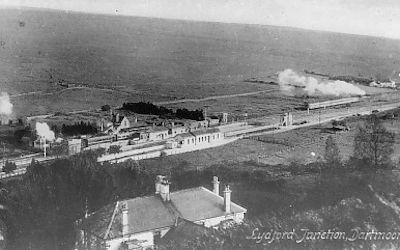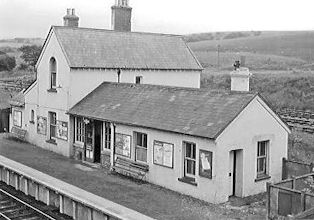|
OLD DEVONPORT
. UK |
||
|
© Brian
Moseley, Plymouth Webpage created: May 12, 2018 Webpage updated: December 21, 2021 |
||
|
RAILWAYS IN OLD DEVONPORT
|
LONDON AND SOUTH WESTERN RAILWAY COMPANY LYDFORD STATION (LSWR/SR/BRSR) SEE ALSO LYDFORD STATION (SDR, GWR,BRWR)
Lydford Junction Station with both Down ands
Up trains in the scene. Lidford Station, as it was then spelt, 23 miles 27 chains from Plymouth Station (Millbay) and 12 miles 21 chains from the terminus at Launceston, was opened by the Launceston and South Devon Railway Company on July 1st 1865. This Company connected end-on at Tavistock with the South Devon and Tavistock Railway to create a branch line from Plymouth right through to Launceston. It was broad-gauge throughout. The Station was joined on its eastern side by an entirely separate one built for the London and South Western Railway Company, which they called Lidford Junction. It was opened to passenger traffic on October 12th 1874. The initial train service comprised six arrivals from Okehampton and beyond and five departures. That line was narrow-gauge, or standard-gauge as it later became, and connected the Town direct with London Waterloo Station. Passengers who insisted on using what was to become in 1876 the Great Western Railway Company's Launceston Branch had to travel to Plymouth first and then to London Paddington Station, a considerably longer journey. At the southern end of the line into the terminal station was a single-road Engine Shed with a turntable outside. On the opening day the first Down train to arrive at Lidford Station just missed by two minutes the departure of the Up Great Western Launceston Branch train to Tavistock and Plymouth. This was to be a common occurrence and on Goosey Fair Day that year the Great Western Railway Company lost 52 return fares from Lidford to Tavistock all because they would not hold their train until the arrival of the LSWR one from Okehampton.
The station buildings on the Southern Region's
Lydford Station On Wednesday August 25th 1875, the magistrates at the Tavistock Petty Sessions granted an annual licence for the sale of wines and spirits and other excisable liquors at the South Devon Railway Company's refreshment room was granted to a Mr Thomas Gregory, who was the tenant. Interestingly, the Magistrates also granted a licence to the 'tenant of the refreshment rooms on the platform of the Lydford (sic) railway station belonging to the London and South Western Railway Company', namely a Mr George Jeffery. Thus Lidford (sic) had two refreshment rooms at that time. 'The Bench remarked that they would rather it could have been so arranged for one set of rooms to have been licenced, but to avoid danger of passengers crossing the lines, they considered it safer to grant the two licences'. Note that The Tavistock Gazette was already spelling Lydford with a "y" in 1875., twenty years before the Station's name was officially altered. On May 17th 1876 the London and South Western Company's line was joined at the southern end of Lidford Station to the Great Western Railway Company's Launceston Branch so that they could exercise their legal running powers to run their trains down through Tavistock, Horrabridge Marsh Mills and North Road Plymouth Station to their new terminus at Devonport for Stonehouse Station. This necessitated the building of Lidford Signal Box, which was actually opened in October 1875. To do so the Great Western Railway Company were obliged to add a third, narrow-gauge rail to their broad-gauge track. This situation lasted until the Plymouth, Devonport and South Western Junction Railway Company built their direct line through Tavistock, Bere Alston, Bere Ferrers, Tamerton Foliot and Ford to join up at the western end of Devonport for Stonehouse Station with the original LSWR line to make Devonport a through station. This new line, which was immediately leased to the LSWR, was opened for passenger traffic on June 1st 1890. The former GWR Booking Office, which was on the Up side, became a waiting room. From that date the LSWR ceased to use the GWR Launceston Branch, which enabled the connection at the southern end of Lidford Station to be removed in 1895. Two years' later, on June 3rd 1897, the name of the Station was changed to "Lydford" although Ordnance Survey maps give the name of the LSWR side as Lydford Junction Station. For a comparative Departure Board for Up GWR and Down LSWR trains at both Lydford Stations heading for Plymouth in April 1910 CLICK HERE. On March 1st 1914 the London and South Western Railway Company took over responsibility for the Great Western Railway Company's Launceston Branch platforms. This was followed in 1917 by the closure of the original GWR and LSWR Signal Boxes and the opening of a new joint GWRC/LSWRC Lydford Signal Box between the Launceston Branch Up platform and the LSWR Up platform, although the two Up trains would have been going in opposite directions. The need to have an alternative route into or out of Plymouth for freight traffic during the Second World War brought about the re-opening of the former link between the two railways at Lydford. This was brought in to operation on November 15th 1943. Mr G Daniel was Station Master at Lydford Station in June 1948. On Weekdays and Sundays, 'where train service permits', commencing on May 1st 1953, the following cheap day return tickets, first and third class, were available from Lydford BRSR to: Devonport King's Road Station, 7s 9d 1st, 5s 3d 3rd; Okehampton, 3s 6d 1st, 2s 3d 3rd; Plymouth Friary Station, 8s 9d 1st, 5s 9d 3rd; Plymouth North Road Station, 7s 9d 1st, 5s 3d 3rd; and Tavistock North, 2s 6d 1st, 1s 8d, 3rd; and from Lydford BRWR Station to: Coryton, 1 shilling (s) 9 pence (d) 1st, 1s 2d 3rd; Horrabridge, 3s 9d 1st, 2s 6d 3rd; Launceston BRWR, 4s 6d 1st, 3s 3rd; Lifton, 2s 9d 1st, 1s 9d 3rd; Plymouth North Road Station, 7s 9d 1st, 5s 3d 3rd; Tavistock South, 2s 6d 1st, 1s 8d, 3rd; and Yelverton, 4s 6d 1st, 3s 3rd. Tickets between Lydford Stations and Devonport King's Road, Plymouth North Road and Tavistock North and Tavistock South stations were available for return by either route. According to the "The Official Hand-book of Station 1956" Lydford BRSR Station dealt with goods traffic, passengers, parcels, miscellaneous traffic, furniture vans, carriages, motor cars, portable engines and machines on wheels, live stock, horse boxes, prize cattle vans, and carriages and motor cars by passenger or parcels trains. It was not equipped with a crane. British Railways closed their Launceston Branch to both goods and passenger traffic on or as from December 31st 1962 although goods traffic continued to be accepted at Lydford Station on the main line until September 7th 1964. The main line side of Lydford Station, which kept its British Railways Southern Region look to the end, was closed to passenger traffic on or as from May 6th 1968.
|
||

